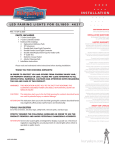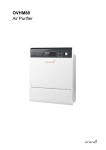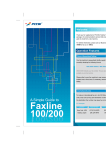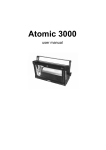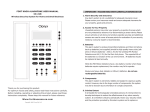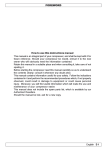Download Service Manual Section 2, A1-A8. 1991
Transcript
Check the start inhibitor switch/reverse lamp switch Check that the engine can only be started when the gear selector lever is in P or N, and that the reversing li ghts are on when the lever is in R. I mportant! Gearbox oil should be at the right level and operating temperature. Move the lever to D and maintain pressure on the brake pedal. Turn the ignition key to the starting position and keep it there. Slowly move the lever to N until the engine starts. Release the brake pedal and check if the car creeps forward. Repeat the test, this time with the lever already in R at the start of the test. The car should not creep in either test. Check the gearshift control I t should only be possible to start the engine in P and N. The reversing light should come on in R. Play in the shift from D to N should be greater than or equal to the play in the shift from 2 to 1. Check the gearshift control I t should only be possible to start the engine in P and N. Note! On cars with an electronic start inhibitor, the gear selector lever should be able to be moved from P only when the engine is on and the brake pedal is pressed. The reversing light should come on in R. The gear selector lever should be vertical in P. Play in the movement from D to N should be noticeable and less than or equal to: - play in movement from 3 to 2 (ZF) - play in movement from 2 to 1 (AW) Check the gearshift control It should only be possible to start the engine in P and N. Drive the car into the workshop bay with the parking brake slightly engaged (pull up handbrake lever until resistance is felt, plus one additional notch). Drive max. 400 metres (max. speed 40 km/h) with the lever i n this position! Check brake performance Full brake effect should be attained at: 2-8 notches for the 200, 700, 940/960, 850 max. 7 notches for the 400 Check that the catch functions and that the warning l amp in the central instrument goes on and off as necessary. Adjustment of parking brake 2401260, 700, 9401960: Adjust inside the car 850 Adjustment should always be performed first at the wheels, as follows: Adjust the brake linings by rotating the link in the brake drum with a screwdriver. Rotate the link until the wheels lock, then release 5 notches. If full braking effect is not attained at 2-8 notches, adjustment should be made at the lever inside the car. 400 Returning the parking brake If fitted, remove the heat shield on the exhaust pipe. Undo adjustment nut (1) until the wires are slack. Use an extended socket (1159202-9 or 9986916-6) on the B 20 F. Disc brakes: - Check that the lever (2) on the brake caliper rests agai nst the stoppers on both wheels. If not, adjust the brake mechanism. (See service manual for brakes, ops. D1 and D5). Drum brakes: - Press the brake pedal firmly at least 20 times to ensure maximum setting for the automatic adjustment mechanism. Adjusting the parking brake Disc brakes: - Turn the adjustment nut (1) in until the lever (2) lies against the stops on both wheels. Drum brakes: - Screw in the adjustment nut (1) until the lug (3) can rotate freely. Check that all exterior lighting functions properly. Check that the glass lenses are undamaged and seal properly. Wipers - check - that the various speeds function, including the intermittent wipe facility. - setting and stop position - tailgate wiper - headlamp wiper function and stop position Adjust if necessary. Check the windscreen washers Adjust the washer nozzles as in the illustrations. Check the tailgate window washer too. Check the headlamp washers I f necessary, adjust the nozzles with a 0.6 mm thick piece of piano wire. Do not use a needle. Note! 400 see below! Auxiliary tools The illustration shows an auxiliary tool which can easily be made in the workshop for adjustment of the headlamp washers on the 400. I nsert the tool in the washer nozzle under-section. Note! Never use the nozzle opening for adjustment. This may damage the nozzle and result in a faulty spray pattern. Adjustment Adjust the nozzles so that the jet of washer fluid strikes the headlamp glass 0-5 mm from the upper edge of the glass. Turn the washer nozzles to the side with the auxiliary tool so that the spray pattern is symmetrical on the right and left sides. Note! 480: In order to test the washer system, the headl amp main beam must be switched on and off for every operation. The system sprays twice in sequence, with an interval of 5 seconds. 4401460: The washer system only functions when the headlamp main beam is switched on. The system sprays washer fluid with a 5-second interval. With extended release fork Measure the distance (A) between the fork and the bracket without touching the clutch pedal. Measure the distance (B) between the fork and the bracket with the clutch pedal pressed to the floor. Adjust the fork's stroke (X) with the adjustment nut so that distance A - B = 30±1 mm. Without extended release fork Measure the distance (A) between the fork and the engine-gearbox contact area without pressing the clutch pedal. Measure the distance (B) between the release fork and the engine-gearbox contact area with the clutch pedal pressed to the floor. Note: Use a pedal hook here. Adjust stroke (X) for the release fork with the help of the adjustment nut so that distance B-A is 22 mm ± 1 mm. Check the kickdown wire's setting Check that the throttle functions properly. Delete the play in the throttle control cam by rotating it clockwise a few mm, see illustration A. (only applies to the B 20) Check the distance (dimension X) between the wire sheath end and the wire stopper. Min. distance 0.1 mm. I f necessary, adjust with the sheath so that the correct distance is obtained. Turn the throttle control until a slight resistance is felt (kickdown-setting). Recheck the distance between the wire sheath end and the wire stopper (dimension Y). Correct distance: 39 mm + dimension X. I f necessary, adjust with the sheath until the correct play is obtained. Kickdown wire, adjustment Remove the wire stopper from the wire. Warning! Be careful not to damage the wire. Attach a new wire stopper loosely to the wire. Turn the throttle control in its middle position. Delete the play in the throttle control cam by turning it clockwise a few mm, see figure A. (applies only to the B 20) Attach the wire stopper (press it in lightly) 1 mm (B 18) or 4 mm (B 20) from the outer end of the sheath (dimension X). Turn the throttle control until a slight resistance is felt (kickdown setting). Keep the throttle control in this position. Measure the distance (dimension Y) from the wire stopper to the sheath end. Correct distance: 39.5 mm + dimension X. Tolerance ± 0.5 mm. If the correct distance cannot be achieved, adjust with the sheath or move the wire stopper. Clamp the wire stopper into its end position. Release the throttle control. Note! Check that the wire stopper does not strike the pulley. Check the setting of the kickdown wire Turn the pulley to the full-throttle stopper. I n this position it should be possible to pull the wire out a further 1 mm (A). Kickdown wire, adjustment Undo the two lock nuts (1), Turn the pulley to the full-throttle stopper and tension the wire by pulling on the sheath's adjustment socket. Note! Do not pull on the sheath itself. Adjust the upper lock nut to obtain a play of 1 mm (B) between the attachment and the nut. Tighten the lower nut (5 Nm). Lock the nuts in place with a coat of paint. Check that the wire is tensioned in the idling setting, without pulling against the pulley, and that it is located securely in the pulley groove, running smoothly in the sheath. Check: Pull the wire out about 10 mm and release it suddenly. A metallic clicking noise should be heard from the throttle cam, when it reaches the standby setting. Wire too firmly tensioned: No clicking sound. Slack wire: No kickdown function. Adjustment: Adjust with the wire tensioner. Note! Winter operation and short driving distances can result in the formation of ice in the flame trap. This may in extreme cases result in destroyed crankcase gaskets. It is therefore important to clean the flame trap thoroughly. • Clean/check the hose • Clean the connection • Clean/check the hose • Clean the connection , . Check the condition of the hoses and check for blockage. • Clean the nipple in the inlet manifold. • Replace the flame trap (does not apply to turbo models). The flame trap should be positioned in the T-piece. • Check the condition of the hoses and check for blockage. • Clean the nipple in the inlet manifold. • Replace the flame trap (does not apply to turbo models). The flame trap should be positioned in the T-piece. • Clean/check the hoses • Clean the calibrated nipple • Clean the oil filler cap, if necessary change the strainer in the cap. • Rotate the flame trap casing about 15 mm to the left (bayonet catch). • Pull out the flame trap and remove the oil filler cap. • Blow-clean the hoses down towards the crankcase ventilation. • I nsert a new flame trap in the inlet hose and rotate the flame trap outer casing back to its original position. Remove the cover above the throttle pulley Undo the hose clamp holding the inlet hose to the air filter housing. Remove the hose from the air filter housing and bend it forward somewhat. Remove the oil filler cap Clean the crankcase ventilation / replace the flame trap Remove the flame trap by rotating it about 15 mm to the left (bayonet catch). Clean the flame barrier casing (2) after the flame trap has been removed. Blow-clean the hoses (1&3). Clean the multi-nipple (4) inlets and outlets. (does not apply to MA' 1995) Note! The nipple on the small hose (3) has a calibrated hole with a diameter of 2.5 mm. (Use a drill for cleaning) I mportant! Do not disconnect the hoses from the flame trap's outer casing. The positioning of the hoses can affect the function of the throttle control. Fit a new flame trap Fit a new flame trap with its outer casing in the inlet hose. Refit all the other parts. • Clean/check the hose • Clean the nipple • Clean/check the hoses • Clean the nipple • Clean/check the hoses • Clean the nipple Check that there is no visible oil leakage and that the fuel lines, coolant lines, vacuum hoses and crankcase ventilation hoses are correctly fitted and are completely tight, with no leakage whatsoever.












